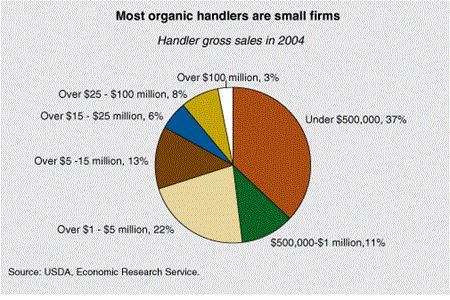U.S. Organic Handlers Mostly Small, Focus on Fruit and Vegetables

Retail sales of organic food increased an average of 17 percent annually between 1995 and 2006. This growth was accompanied by significant changes in organic food marketing. Organic versions of conventional brands (such as Organic Rice Krispies) and private label organic products are now commonly sold alongside longtime organic brands (such as the Safeway “O” line of organic products).
These trends have increased the quantity of organic foods grown, processed, and distributed in the U.S. and placed new pressures on manufacturers and distributors of organic products. Supply chains that once served distinct market channels now provide organic food to both the natural product and conventional channels. Handlers, the firms that manufacture, process, and distribute organic foods, are central to the evolving supply chains. A new ERS study provides baseline information about handlers of organic products in 2004.
Organic handlers are typically small firms, with 48 percent reporting sales below $1 million annually, and 22 percent between $1 and $5 million per year. Most organic handlers are mixed operations, handling both conventional and organic products. Nearly two-thirds of these firms began their businesses by producing and selling conventional products, later adding organic foods. Organic products accounted for 34 percent of handler sales in 2004. Handlers report they expect the share of organic sales to increase to an average of 42 percent by 2009.
Fruit and vegetables were the top organic product category sold by handlers in 2004, followed by dairy products and breads, grains, or seeds. The main marketing outlets for handlers are wholesalers, brokers, distributors and repackers, followed by retail outlets. Organic handlers’ sales to retail natural-product stores were nearly double their sales to supermarkets and club stores. Small handlers were more likely to market their products to natural-product stores than to conventional supermarkets, while large handlers were more likely to sell to natural-product chains and conventional supermarkets.
Although national organic standards were developed in part to facilitate international trade, exports accounted for only 7 percent of organic product sales in 2004. Of U.S. sales, 39 percent were national and 30 percent were regional. Local (within an hour’s drive of the handlers’ facilities) sales amounted to 24 percent of handler sales to U.S. outlets.
The organic sector is poised to continue growing into the next decade, further increasing the flow of organic products distributed and processed by handlers. The data from the ERS study will enable researchers to examine the factors influencing handlers’ marketing decisions, such as the choice of outlets or the geographical range of sales (local, regional, national, and international).
The U.S. Organic Handling Sector in 2004: Baseline Findings of the Nationwide Survey of Organic Manufacturers, Processors, and Distributors, by Carolyn Dimitri and Lydia Oberholtzer, USDA, Economic Research Service, May 2008
Organic Handlers: Procurement and Contracting, USDA, Economic Research Service, August 2019
Organic Agriculture, by Sharon Raszap Skorbiansky, USDA, Economic Research Service, January 2024
Organic Prices, USDA, Economic Research Service, September 2019
Organic Production, USDA, Economic Research Service, September 2019


